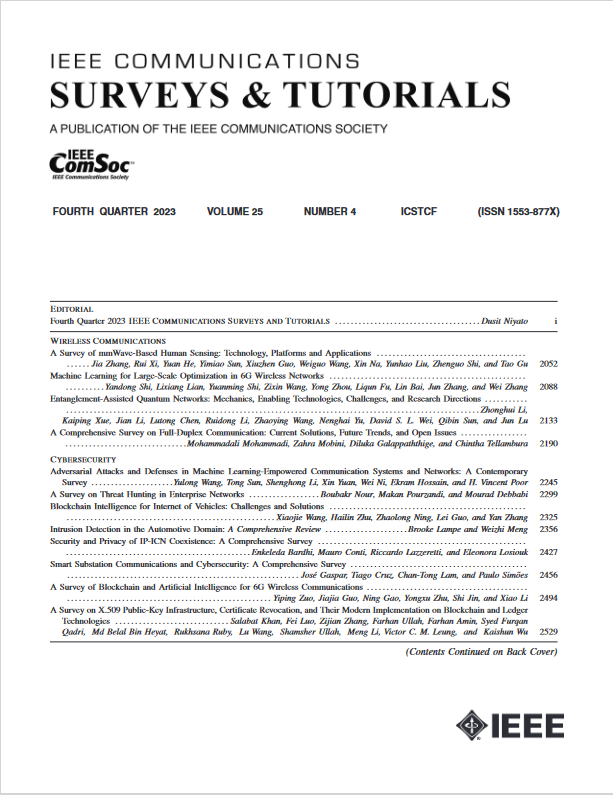A Tutorial on Fluid Antenna System for 6G Networks: Encompassing Communication Theory, Optimization Methods and Hardware Designs
IF 34.4
1区 计算机科学
Q1 COMPUTER SCIENCE, INFORMATION SYSTEMS
引用次数: 0
Abstract
The advent of the sixth-generation (6G) networks presents another round of revolution for the mobile communication landscape, promising an immersive experience, robust reliability, minimal latency, extreme connectivity, ubiquitous coverage, and capabilities beyond communication, including intelligence and sensing. To achieve these ambitious goals, it is apparent that 6G networks need to incorporate the state-of-the-art technologies. One of the technologies that has garnered rising interest is fluid antenna system (FAS) which represents any software-controllable fluidic, conductive, or dielectric structure capable of dynamically changing its shape and position to reconfigure essential radio-frequency (RF) characteristics. Compared to traditional antenna systems (TASs) with fixed-position radiating elements, the core idea of FAS revolves around the unique flexibility of reconfiguring the radiating elements within a given space. One recent driver of FAS is the recognition of its position-flexibility as a new degree of freedom (dof) to harness diversity and multiplexing gains. In this paper, we provide a comprehensive tutorial, covering channel modeling, signal processing and estimation methods, information-theoretic insights, new multiple access techniques, and hardware designs. Moreover, we delineate the challenges of FAS and explore the potential of using FAS to improve the performance of other contemporary technologies. By providing insights and guidance, this tutorial paper serves to inspire researchers to explore new horizons and fully unleash the potential of FAS.6G 网络流体天线系统教程》:涵盖通信理论、优化方法和硬件设计
第六代(6G)网络的出现为移动通信领域带来了另一轮革命,有望带来身临其境的体验、强大的可靠性、最小的延迟、极致的连接性、无处不在的覆盖范围以及超越通信的功能,包括智能和传感。为了实现这些雄心勃勃的目标,6G网络显然需要结合最先进的技术。流体天线系统(FAS)是引起人们日益关注的技术之一,它代表了任何软件可控的流体、导电或介电结构,能够动态改变其形状和位置,以重新配置基本射频(RF)特性。与具有固定位置辐射元件的传统天线系统(TASs)相比,FAS的核心思想围绕着在给定空间内重新配置辐射元件的独特灵活性。FAS最近的一个驱动力是人们认识到它的位置灵活性是一种利用多样性和多路复用收益的新自由度(dof)。在本文中,我们提供了一个全面的教程,涵盖信道建模,信号处理和估计方法,信息论的见解,新的多址技术和硬件设计。此外,我们描述了FAS的挑战,并探讨了使用FAS改善其他当代技术性能的潜力。本文将为研究人员提供真知灼见和指导,以激发研究人员探索新的领域,充分释放FAS的潜力。
本文章由计算机程序翻译,如有差异,请以英文原文为准。
求助全文
约1分钟内获得全文
求助全文
来源期刊

IEEE Communications Surveys and Tutorials
COMPUTER SCIENCE, INFORMATION SYSTEMS-TELECOMMUNICATIONS
CiteScore
80.20
自引率
2.50%
发文量
84
审稿时长
6 months
期刊介绍:
IEEE Communications Surveys & Tutorials is an online journal published by the IEEE Communications Society for tutorials and surveys covering all aspects of the communications field. Telecommunications technology is progressing at a rapid pace, and the IEEE Communications Society is committed to providing researchers and other professionals the information and tools to stay abreast. IEEE Communications Surveys and Tutorials focuses on integrating and adding understanding to the existing literature on communications, putting results in context. Whether searching for in-depth information about a familiar area or an introduction into a new area, IEEE Communications Surveys & Tutorials aims to be the premier source of peer-reviewed, comprehensive tutorials and surveys, and pointers to further sources. IEEE Communications Surveys & Tutorials publishes only articles exclusively written for IEEE Communications Surveys & Tutorials and go through a rigorous review process before their publication in the quarterly issues.
A tutorial article in the IEEE Communications Surveys & Tutorials should be designed to help the reader to become familiar with and learn something specific about a chosen topic. In contrast, the term survey, as applied here, is defined to mean a survey of the literature. A survey article in IEEE Communications Surveys & Tutorials should provide a comprehensive review of developments in a selected area, covering its development from its inception to its current state and beyond, and illustrating its development through liberal citations from the literature. Both tutorials and surveys should be tutorial in nature and should be written in a style comprehensible to readers outside the specialty of the article.
 求助内容:
求助内容: 应助结果提醒方式:
应助结果提醒方式:


